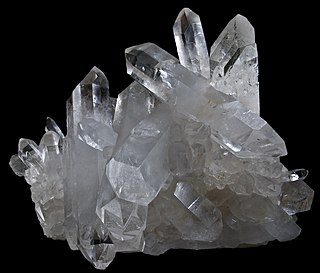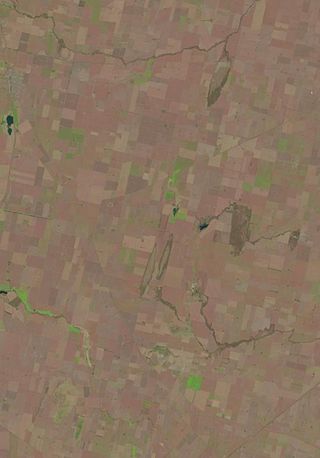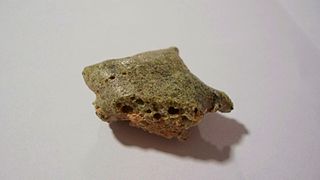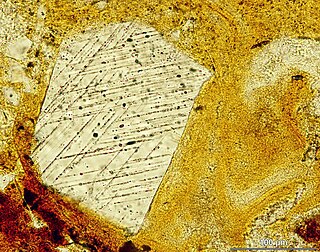Related Research Articles

Quartz is a hard, crystalline mineral composed of silica (silicon dioxide). The atoms are linked in a continuous framework of SiO4 silicon–oxygen tetrahedra, with each oxygen being shared between two tetrahedra, giving an overall chemical formula of SiO2. Quartz is, therefore, classified structurally as a framework silicate mineral and compositionally as an oxide mineral. Quartz is the second most abundant mineral in Earth's continental crust, behind feldspar.

The Río Cuarto craters are a purported group of impact craters located in Córdoba Province, Argentina. Research published in 2002 indicates that they are more likely a result of aeolian processes.

Tektites are gravel-sized bodies composed of black, green, brown or grey natural glass formed from terrestrial debris ejected during meteorite impacts. The term was coined by Austrian geologist Franz Eduard Suess (1867–1941), son of Eduard Suess. They generally range in size from millimetres to centimetres. Millimetre-scale tektites are known as microtektites.

Fulgurites, commonly called "fossilized lightning", are natural tubes, clumps, or masses of sintered, vitrified, or fused soil, sand, rock, organic debris and other sediments that sometimes form when lightning discharges into ground. When composed of silica, fulgurites are classified as a variety of the mineraloid lechatelierite.

Trinitite, also known as atomsite or Alamogordo glass, is the glassy residue left on the desert floor after the plutonium-based Trinity nuclear bomb test on July 16, 1945, near Alamogordo, New Mexico. The glass is primarily composed of arkosic sand composed of quartz grains and feldspar that was melted by the atomic blast. It was first academically described in American Mineralogist in 1948.

Shocked quartz is a form of quartz that has a microscopic structure that is different from normal quartz. Under intense pressure, the crystalline structure of quartz is deformed along planes inside the crystal. These planes, which show up as lines under a microscope, are called planar deformation features (PDFs), or shock lamellae.

Shoemaker is an impact structure, the deeply eroded remnant of a former impact crater, situated in arid central Western Australia, about 100 km (62 mi) north-northeast of Wiluna. It is named in honour of planetary geologist Eugene Shoemaker.

Strangways is a large impact structure, the eroded remnant of a former impact crater, located in the Northern Territory of Australia about 65 kilometres (40 mi) east-south-east of the town of Mataranka. It was named after the nearby Strangways River. The location is remote and difficult to access. Its age has been determined as approximately 646 Ma.

Shatter cones are rare geological features that are only known to form in the bedrock beneath meteorite impact craters or underground nuclear explosions. They are evidence that the rock has been subjected to a shock with pressures in the range of 2–30 GPa (290,000–4,350,000 psi).

Lechatelierite is silica glass, amorphous SiO2, non-crystalline mineraloid. It is named for Henry Louis Le Chatelier.

Libyan desert glass or Great Sand Sea glass is an impactite, made mostly of lechatelierite, found in areas in the eastern Sahara, in the deserts of eastern Libya and western Egypt. Fragments of desert glass can be found over areas of tens of square kilometers.
Gerta Keller is a geologist and paleontologist whose work has focused on global catastrophes and mass extinctions. She has been a professor of geosciences at Princeton University since 1984 and received emeritus status in July 2020. Keller contests the mainstream Alvarez hypothesis that the impact of the Chicxulub impactor, or another large celestial body, directly caused the Cretaceous–Paleogene extinction event. Keller maintains that such an impact predates the mass extinction and that Deccan volcanism and its environmental consequences were the most likely major cause, but possibly exacerbated by the impact. Considered a leading authority on catastrophes and mass extinctions, including the biotic and environmental effects of impacts and volcanism, Keller is one of few scientists whose work has consistently supported the contention, with nearly half of her 300 publications being articles which address the asteroid impact/volcano controversy
The term iridium anomaly commonly refers to an unusual abundance of the chemical element iridium in a layer of rock strata at the Cretaceous–Paleogene (K–Pg) boundary. The unusually high concentration of a rare metal like iridium is often taken as evidence for an extraterrestrial impact event.

Glikson crater is an impact structure, the eroded remnant of a former impact crater, situated in the Little Sandy Desert of central Western Australia. A possible impact structure was first reported in 1997, and named after Australian geologist A. Y. Glikson, attention to the site being drawn by the presence of a prominent 14 km diameter ring-shaped aeromagnetic anomaly. The area within the ring contains sparse outcrop of uplifted and deformed Neoproterozoic sandstone, but is largely covered by sand dunes. The recent discovery of shatter cones and microscopic shock effects is reliable evidence for an impact origin. Deformation of the sandstone consistent with an impact origin extends out to a diameter of 19 km, which is the best estimate for the original diameter of the original crater. The ring-shaped aeromagnetic anomaly was probably caused by disruption of a horizontal layer of magnetic igneous rock, known as a sill, by the impact event. Nearby outcrops of dolerite have been dated at 508 ± 5 Ma (Middle Cambrian), and if this is the same rock causing the aeromagnetic anomaly, then the impact must be younger, probably of Paleozoic age.
Paleolightning refers to the remnants of ancient lightning activity studied in fields such as historical geology, geoarchaeology, and fulminology. Paleolightning provides tangible evidence for the study lightning activity in Earth's past and the roles lightning may have played in Earth's history. Some studies have speculated that lightning activity played a crucial role in the development of not only Earth's early atmosphere but also early life. Lightning, a non-biological process, has been found to produce biologically useful material through the oxidation and reduction of inorganic matter. Research on the impact of lightning on Earth's atmosphere continues today, especially with regard to feedback mechanisms of lightning-produced nitrate compounds on atmospheric composition and global average temperatures.
Reidite is a rare polymorph of ZrSiO4 created when zircon experiences high pressure and temperature. Reidite is denser than zircon and has the same crystal structure as scheelite. All natural occurrences of reidite are associated with meteorite impact events.
Hypatia is a small stone found in Egypt in 1996. It has been claimed to be both a meteorite and kimberlite debris. It has also been claimed to be the first known specimen of a comet nucleus on Earth, although defying physically-accepted models for hypervelocity processing of organic material. As of November 2023, Hypatia has not been officially classified as a meteorite in the Meteoritical Bulletin, which is tasked with recording all scientifically proven meteorites.
Astropedology is the study of very ancient paleosols and meteorites relevant to the origin of life and different planetary soil systems. It is a branch of soil science (pedology) concerned with soils of the distant geologic past and of other planetary bodies to understand our place in the universe. A geologic definition of soil is “a material at the surface of a planetary body modified in place by physical, chemical or biological processes”. Soils are sometimes defined by biological activity but can also be defined as planetary surfaces altered in place by biologic, chemical, or physical processes. By this definition, the question for Martian soils and paleosols becomes, were they alive? Astropedology symposia are a new focus for scientific meetings on soil science. Advancements in understanding the chemical and physical mechanisms of pedogenesis on other planetary bodies in part led the Soil Science Society of America (SSSA) in 2017 to update the definition of soil to: "The layer(s) of generally loose mineral and/or organic material that are affected by physical, chemical, and/or biological processes at or near the planetary surface and usually hold liquids, gases, and biota and support plants". Despite our meager understanding of extraterrestrial soils, their diversity may raise the question of how we might classify them, or formally compare them with our Earth-based soils. One option is to simply use our present soil classification schemes, in which case many extraterrestrial soils would be Entisols in the United States Soil Taxonomy (ST) or Regosols in the World Reference Base for Soil Resources (WRB). However, applying an Earth-based system to such dissimilar settings is debatable. Another option is to distinguish the (largely) biotic Earth from the abiotic Solar System, and include all non-Earth soils in a new Order or Reference Group, which might be tentatively called Astrosols.
References
- 1 2 3 Haines, P.W., R.J.F. Jenkins, and S.P. Kelley, 2001, Pleistocene glass in the Australian desert: The case for an impact origin. Geology. v. 29, no. 10, pp. 899–902.
- 1 2 3 Macdonald, F.A., K. Mitchell, and S.E. Cina, 2004, Evidence for a Lightning-Strike Origin of the Edeowie Glass. 35th Lunar and Planetary Science Conference, March 15–19, 2004, League City, Texas, abstract no.1406.
- ↑ Gifford, A. C., 1999, "Clay soil fulgurites in the Eastern Goldfields of Western Australia" (PDF). Journal of the Royal Society of Western Australia, 82:165–168, 1999
- ↑ Roperch, Pierrick; Gattacceca, Jérôme; Valenzuela, Millarca; Devouard, Bertrand; Lorand, Jean-Pierre; Arriagada, Cesar; Rochette, Pierre; Latorre, Claudio; Beck, Pierre (2017). "Surface vitrification caused by natural fires in Late Pleistocene wetlands of the Atacama Desert". Earth and Planetary Science Letters. 469 (1 July 2017): 15–26. Bibcode:2017E&PSL.469...15R. doi:10.1016/j.epsl.2017.04.009.
- ↑ "Lightning-induced shock lamellae in quartz". Ammin.geoscienceworld.org. 2015-07-01. Retrieved 2015-08-16.
- ↑ Melosh, H.J. (2017). "Impact geologists, beware!". Geophysical Research Letters. 44 (17): 8873–8874. Bibcode:2017GeoRL..44.8873M. doi:10.1002/2017GL074840.